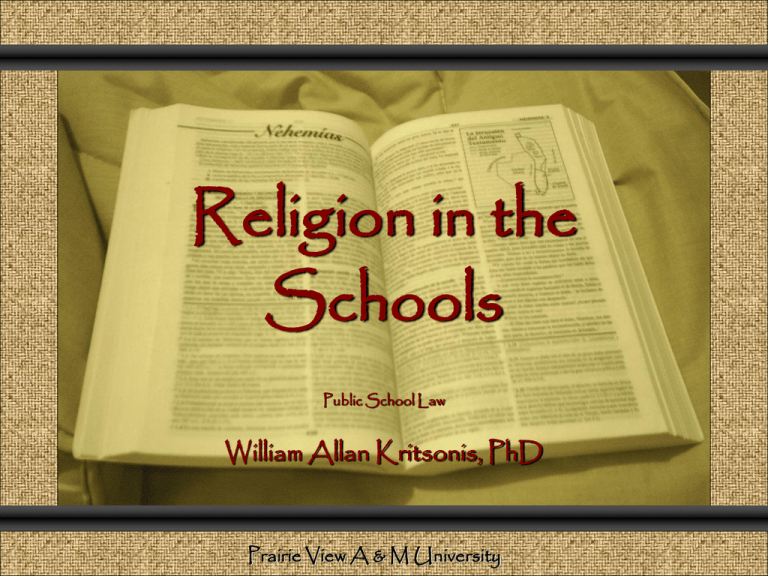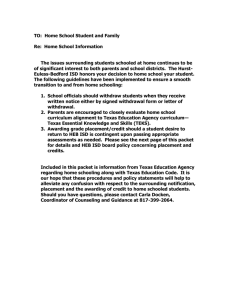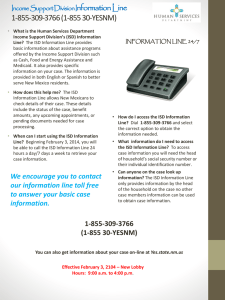document
advertisement

Comunicación y Gerencia Religion in the Schools Public School Law William Allan Kritsonis, PhD Prairie View A & M University •Religion in the public school system becomes more and more controversial due to diversity in today’s family backgrounds and beliefs. •Contemporary issues make it even more difficult to draw the line between what is legal and what is not. Legal Framework • Since our US Constitution and Bill of Rights were written by our forefathers of this country, it was apparent that they took the relationship between government and religion seriously. • The First Amendment to the US Constitution began with “Congress shall make no law respecting an establishment of religion, or prohibiting the free exercise thereof…” Provisions through the Fourteenth Amendment: two components • Establishment clause: states that “Congress shall make no law respecting an establishment of religion” • Free exercise clause: states that “or prohibits the free exercise thereof”. • These provisions are also know as the “Jeffersonian Principle of separation of church and state”. Landmark cases: • Everson v. Board of Education (1947)- first major case involving the establishment clause and education. • McCollum v. Board of Education (1948) • Zorach v. Clauson (1952) Judges in these cases did not agree and sometimes switched sides. Much criticism is targeted towards Supreme Court decisions and continues today. 1787 Northwest Ordinance, 1st federal act to aid in education • States that “religion, morality, and knowledge being essential to good government and the happiness of mankind, schools and the means of education shall forever be encouraged”. • This federal act aided Justices to develop and set up guidelines to resolve complicated church-state issues. These guidelines were known as the “Lemon guidelines” 1st guideline: the purpose of a challenged law or practice must be secular (not sectarian) 2nd guideline: the primary effect of the law or practice must be one that neither advances nor inhibits religion 3rd guideline: the law or practice must not involve excessive entanglement between state and church (aids private schools) **For a law to be constitutional, it had to pass all three guidelines; a law must be neutral regarding religion; neither promoting or retarding it. Landmark cases involving Lemon guidelines: • Agular v. Felton (1985) • Lee v. Weisman, (1992) • Board of Education of Kryas Joel Village School District v. Grument (1994) • Rosenberger v. University of Virginia (1995) • Agostini v. Felton (1997) Free Exercise of Religion • Under the free exercise clause, it assures that people shall be free to exercise their religious beliefs without government restraint or persecution. • This applies to states and their political subdivisions, including public school districts, under the Fourteenth Amendment. • Yet, there are limits to what courts will allow under the free exercise clause. Examples of where religion has its limitations by: • Beliefs accompanied by actionsex. In Reynolds v. United States (1878) Based on their belief, Mormons believe to have a right to polygamy, Congress has a right to prohibit its practice. • Sacrifices • Heresy (United States v. Ballard, 1944) Provisions that protect religion: • Title VII of the 1964 Civil Rights Act • Chapter 21 of the Texas Labor Code • § 106.001 of Title 5 of the Civil Practices and Remedies Code • Texas Education Code § 25.901 • Texas Religion Freedom Act, Texas Legislature 1999 • The 1993 U.S. Supreme ruling- Lamb’s Chapel v. Center Moriches Union Free School District (prohibits school officials from denying religious groups the same access to school facilities afforded to other community organizations. Other cases involving the free exercise clause: • Milford Central School of Milford, New York v. U.S. Supreme Court (2001) • Campbell v. St. Tammany Parish School Board (2003) • Roe v. Klein ISD (1982) • Torcaso v. Watkins (1961) Contemporary Issues The Pledge of Allegiance • The Texas Education Code, TEC § 25.082, requires students to recite the pledge of allegiance to both the U.S. and Texas flag in all public school systems. • In 1954, Congress added “under God” following “one nation”. • This addition has created public debate.(ex. Goetz v. Ansell, 1973; Elk Grove Unified Scool District v, Newdow, 2004). • TEC § 1.004, permits public schools and institutions of higher education to post the national motto “In God We Trust”. *Today, this motto has not been declared unconstitutional. School Prayer • School-sponsored or Employee led prayer-arguments have been advanced that prohibiting state-mandated prayer programs in public schools inhibits the religious freedom of those who wish to say such prayers. Landmark cases: • Engel v. Vitale (1962), School District of Abington v. Schempp (1963), Meltzer v. Board of Public Instruction and Karen B. v. Treen (1981), Doe v. Duncanville ISD, (1995) • Yet, the law is clear that neither the public school nor its employees may sponsor prayer at school or at extracurricular activities and athletic events. School Prayer (con’t) • Trying to bring prayer back into school, “silent meditation” was ruled in 1997 by the US Court of Appeals for the Eleventh Circuit in the Bown v. Gwinett County School case. • Silent meditation authorizes public schools to set aside time for meditation or prayer, protecting every student’s right to engage in voluntary prayer. School Prayer (con’t) • Invocations, benedictions, religious speeches at graduation and baccalaureate ceremonies – The US Department of Education has issued religious practices guidelines that provide that “where students or other private graduation speakers are selected on the basis of genuinely neutral, evenhanded criteria and retain control over the content of their expression..that expression is not attributable to the school and therefore may not be restricted because of its religious content”. Landmark cases: • • • • • Marsh v. Chambers (1983) Jones v. Clear Lake ISD (1994) Harris v. Joint School District (1994) Ingebretsen v. Jackson Public School District (1996) Doe v Santa FE ISD (1999) Summary: Both the federal courts and the TEC recognize that students can engage in personal prayer at school and at school-sponsored extracurricular and athletic events separate and apart from school involvement. Teaching Creation-Science • The US Supreme Court found absence of a secular purpose and a neutral effect in teaching evolution in the public school system in the Epperson v. Arkansas case (1968). • Would it be the same if a teacher taught the biblical perspective of creation in a public school? Cases that points out to this theoretical question: • In Edwards v. Aguillard (1987),the courts settled and entitled that there were to be a balance in the teaching of both creation and evolution through the Creation-Science and Evolution-Science Act; prohibiting anyone from discriminating the Evolution-Science under the basis of religion. • It is important to note that a school district is not confined to teaching only evolution. • Yet, in the case Peloza v. Capistrano Unified School District, the lower courts ruled in favor of the districts to confine a teacher’s teaching to evolution and cease attempting to influence students toward personal religious beliefs. • In Webster v. New Lenox, a social studies teacher tried to also teach creation as a means to balance views, but was ruled by the Seventh Circuit that the teacher did not have a First Amendment right to teach creation-science. Secular Humanism and Pagan Religion • “To require the teaching of every theory of human origin, as alternative suggested by plaintiffs, would be an unwarranted intrusion into the authority of public school systems to control the academic curriculum”, decision note on Wright v. Houston ISD (1972). • Other similar cases: Smith v. Board of School Commissioners of Mobile County (1987), Brown v. Woodland Joint Unified ISD Religion in Classrooms, Choir Programs, and Holiday Observances • Legally, teaching about religion requires a curriculum that does not favor or denigrate any particular religion or religion in general and teachers who remain neutral.(Hall v. Board of School Commissioners, 1981) • Teaching religion is acceptable ultimately if it is used for the purposes of comparing theories, for its historic content, and for “ the relationship to the advancement of civilization” and if it promotes religious tolerance. • Other cases: Zorach v. Clauson (1952), Herdahl v. Pontotoc County School District (1996) Six guidelines for teaching about religion in the public school system: 1. 2. 3. 4. 5. 6. The school’s approach to religion must be academic, not devotional. The school may strive for student awareness of religion but should not press for student acceptance of any one religion. The school may sponsor study about religion but may not sponsor the practice of religion. The school may expose students to a diversity of religious views but may not impose any particular view. The school may educate about all religions but may not promote or denigrate any religion. The school may inform the student about various beliefs but should not seek to confine him or her to any particular belief. (*developed by seventeen religious and educational organizations) Clergy in the School • TEC § 37.102 allows the district to establish rules to protect the welfare of students. • TEC § 37.105 allows the district to require identification of all persons and to refuse entry to persons without legitimate business. • Schools cannot give the appearance of endorsing religion (Oxford v. Beaumont ISD, 2002) Distribution of Religious Literature • It is impermissible that school personnel or outside organizations to distribute Bibles and other religious material to public school students on school grounds. • Yet, it is permissible to provide a place in a public school where adherents of any faith may deposit religious literature for voluntary student pickup. • In 1992,in the case Clark v. Dallas ISD, a federal judge ruled that a student may distribute religious material being that this is within the ambit of the First Amendment free speech clause. Wearing Religious Symbols • Under Title VII of the 1964 Civil Rights Act, the school district must accommodate reasonable a teacher’s wearing of religious symbols and attire unless it would be undue hardship to do so. (U.S. v. Board of Education for the School District of Philadelphia) • Students also have limited personal grooming rights under federal and state law. (Alabama and Coushatta Tribes of Texas v. Big Sandy ISD) Student Religious Groups and the Equal Access Act • In the case Widmar v. Vicent (1981), the US Supreme Court upheld the right to student groups to hold religious services in buildings on a public university campus. • In 1984, Congress passed the Equal Access Act which gives non-curriculumrelated student groups access to public secondary schools during non-instructional time to engage in religious, political, philosophical, or other types of expression. Religious Exemptions • West Virginia State Board of Education v. Barnette (1943)- most celebrated case Court ruled that the school board count not compel Jehovah’s Witnesses to salute the flag. This case asserted that the government may never compel a person to profess a belief. TEC §26.010 gives parents the right to request exemptions from school activities to which they object on religious or moral grounds. other cases: Wisconsin v. Yoder (1972), Davis v.Page (1974), Mozert v. Hawkins County Board of Education (1987). Religious Exemptions (con’t) Congress enacted legislation in 1993 with the Religious Freedom Restoration Act to protect religious rights. This act: – Provided that government shall not substantially burden a person’s exercise of religion. – This act did not last long; this act was declared unconstitutional (City of Boerne V. Flores (1997) – Later in 1999, the Texas legislature entitle a similar measure called the Texas Religion Freedom Act (TRFA)- it gives both employees and students new support for religiously motivated behavior. . Other provisions that grant exemptions for religious reasons from school related requirements are: – TEC §26.010 which gives parents the right to request an exemption from classroom moral beliefs, provided the parent presents a written request and the purpose is not to avoid a test or prevent a child from taking a subject for an entire semester. (in 1999, legislature eliminated the written request) – TEC §25.087 requires school districts to excuse a student from school for religious observances. – TEC §38.001 grants an exemption from immunizations requirements for students entering elementary or secondary schools upon presenting an affidavit stating that the student “declines immunization for reasons of conscience, including religious beliefs”. Assistance to Sectarian Schools • Efforts have been made to have all students attend public school (Pierce v. Society of Sisters,1995) • Despite the rise of public schools, efforts have also been made to find ways to aid private schools directly, or by providing tuition vouchers or tax credit for students who enroll in these private schools. • Only 11 percent of the total US school enrollment attends private schools. • 30 percent of the private schools are religiously affiliated to the Roman Catholic religion. Conclusion • We cannot ignore the fact that there is a “thin line” in the relationship between education and religion. • It is also clear that the US Constitution does mandate that the public school system remain neutral regarding religion, yet at the same time, both the US and Texas constitutions provide strong support for individual freedom of religious belief and exercise. • Endorsing or accommodating religion make it difficult for all levels where decision making is involved. Personal thought: “It is not religion, but a relationship that determines that connection in our spiritual life that above all will prevail.”







